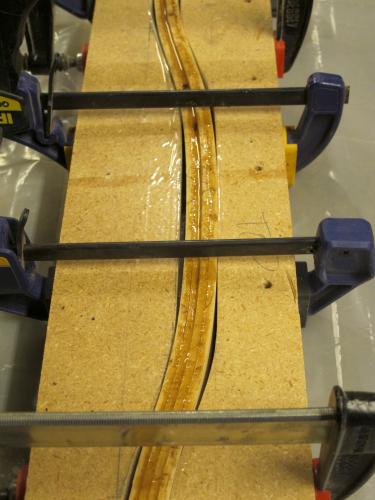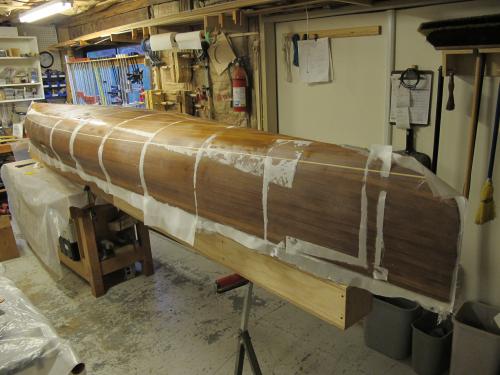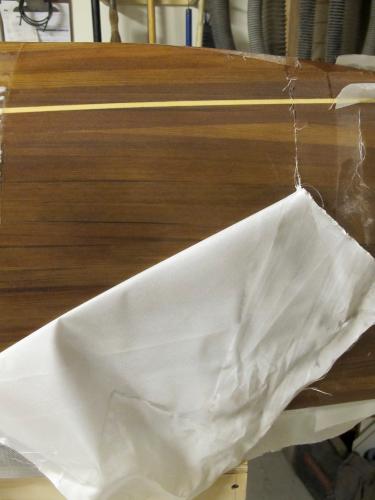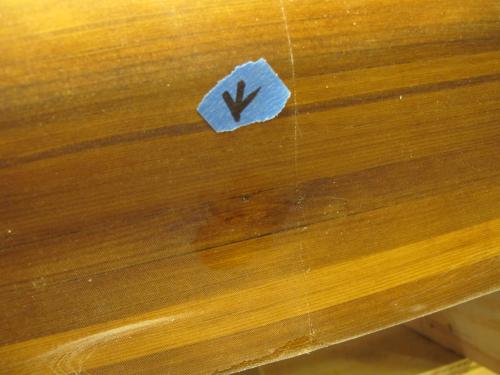Building the Ashes Solo Day
12
12
|
I'd been thinking about a faster, lighter canoe for a while. Then I had a chance to paddle with a friend in his big double that, with two relatively experienced paddlers, we could make move pretty well. I knew I had to build another canoe. As the rains set in, I researched a lot of boats but settled on the Solo Day from Ashes Still Water Boats. It's a 15' single with a total width of 29", an asymmetric hull and a projected weight in the low thirties. Plans were ordered.
A week or so after receiving the plans, I headed off to my local Parr Lumber in search of deck boards. That's right, deck boards. In my neighborhood there are a lot of 60's & 70's homes with cedar decks. Parr stocks replacement 2 X 6 cedar decking that they classify as "tight-knot green". When I tell the sales clerk that I'm building a canoe, he tells me to go on out and take a look. The vertical grain WRC gods were with me on this day as I found two 16' planks that were tight vertical grain and a delicious dark chocolate brown in color. The planks were paid for, loaded on the car and carried home. The following week, Bruce came over and helped me rip 5/8" X 1 1/2" blanks to cut the strips from. Those are stickered and drying on the floor of the shop. While they dry, I'll cut my station molds and the extension to the box beam that serves as a strong back. |
|
I collected all of the MDF & surplus plywood for my station molds. I was able to get away with only buying one sheet of plywood for both the strong back extension and the last couple of molds. A quick trip to Fed-X to make 15 copies of the station molds and I was set to go. The mold patterns were glued to the sheet goods and the molds were cut out on the bandsaw.
 They will get cleaned up with a sanding block. Feet were made to support the stations and they were all put in one place.  |
|
Since the last time... A couple of things have happened. First, the scarfs were made in the contrast strips and out wale blanks. These are Alaskan Yellow Cedar. This wood is delightful in its aroma. You really need to experience it in your life!
 Next task was the seat. Lot's to do, but i decided to laminate these pieces. Stronger, lighter but more more labor.  These laminated Alaskan Yellow Cedar elements are very light and strong. While I was doing this, the extension of the box beam strong back was made.  This will be joined to its mate as we assemble the strong back. Next, the second seat thwart will be made and the assembly will be prepared. this is really a pretty cool process. Everyone should try it! |
|
So here we go on the seat. Here's the bare lamination, out of the mold.
 After this, the laminated parts were planed true and cut to finished width on the table saw.  The parts were rough shaped on the router table to make a radiussed set of parts. Then the dowel joints were made to join the four parts together.   The parts were glued up with thickened epoxy. This assembly was made of Alaskan Yellow Cedar to match much of the rest of the boat. If I were do it again, I'd probably make these from CVG Fir. Similar weight, a little bit stronger and not so prone to split - though still prone to split. It seems like the CVG Fir is a better laminating material. Just my preference. |
|
One Spring day there was sunshine on the deck so it was time to cut strips! In order to cut 16' strips I need to back my tablesaw up to the door, open the door, then use the deck as my infeed and the shop as the outfeed.
 The 2 X 6 planks had been ripped to 5/8" wide by 1 1/2" thick. Now, lots of pressure had to be applied to align them to slice the stock to 3/16"+ X 5/8".  Dust mask, safety goggles and all of your faculties are needed for this task. By early afternoon I had strips for a canoe along with cedar gunnels. 
|
|
With the strips cut and stowed on the rack, it was time to assemble the strong back and mount the forms. I decided to use the strong back on top of my bench which placed the canoe forms higher than normal. I did this for a few reasons, but it did avoid moving the bench which is deadly heavy! Also, the bench end of the shop is only 7' wide, so when I move the bench to the side, it means moving the strong back from side to side in the shop to get clearance.
 This placement means that I'll be working off a step stool to do the bottom. Not a problem. It means the strips near the sheer are closer to eye height, too! Next post: The first strips. |
|
Once the forms were positioned and leveled on the strong back, it was time to make sure everything was fair. A few strips were clamped into position. Most everything was looking pretty good, some minor adjustments were made and it was time to start. The first strips to be mounted are the waterline and the sheer line. The sheer was nailed with brads as the holes will be covered with the outwale.
 The waterline is a contrasting strip of 1/2" Alaskan Yellow Cedar. It seemed a little bit balky, but I stayed with it and got it into place.  The sheer was able to be faired on the forms which was very nice to do. On this boat, the upper strips are parallel to the sheer, which is a good look, I think. An easier method is to make all of the strips parallel to the waterline, then plane the sheer to shape. |
|
This post was updated on .
I'm not sure if I have mentioned that this boat is being built with rolling bevels rather than cove and bead, and without staples or fasteners. All of the strips are glued and clamped. Between stations, blue painter's tape is used to 'clamp the strips together and keep them aligned. When they need to be attached to the forms, that is done with hot melt glue. I feel the beveled strips, as imperfect as they are, give a better finished appearance than cove and bead. Cove and bead are self aligning and nice to use, but the fragile edges of the coves tend to fracture. I like the finished appearance of the beveled strips. Chef's choice.
 Lots of strips on this boat and I'm liking the look. Please note: The originally planned 1/2" waterline strip of AYC was abandoned in favor of a less than 1/4" strip. The 1/2" strip, which was kiln dried, wouldn't relax enough to make the twists required. Even the heat gun didn't allow it to be formed. As it is, for this boat, I like the thinner strip. It is a minimalist statement for a minimalist boat. |
|
Here is a photo of the clamping method. The big red spring clamps are used to hold a notched plywood clamping assist. The clamping assist fits around the top, bottom and side of each strip. There are one of these at each station. The blue painter's tape is used to clamp the strip to be glued tightly to the next. Smaller spring clamps are used to help the adhesive stick to the raw cedar.
 Another share on technique are the glue bottles below. Each strip gets a thin bead of Titebond on the surface to be glued. These little bottles do that perfectly and are easier to use than a big bottle. Having two is a good idea as they are fairly small, maybe 2 ounces. 
|
|
Applying the strips is a time consuming process. Sometimes when the strips need to twist or bend, it helps to over-twist them then hit them with the heat gun. This is one of the advantages of using cedar that hasn't been kiln dried - the life hasn't been cooked out of it and it will take a set with the application of a little heat.
 The photo shows that the planking - 'stripping' - is coming along nicely. |
|
This post was updated on .
In this post, i will spend a few words on the arrangement of strips. Lots of ways to do it and I suggest that you do some research to choose the approach that seems right to you. In the case of this boat, everything keys from the waterline and the sheer. All of the strips below the sheer and above the waterline follow the sheer. At bow and stern, there is a triangle that has to be filled by trimming strips to fit.
Oh - and don't forget that nasty strip that is full length that has to be shaped between the lowest full strip following the sheer and the full strip that follows the waterline. Take your time. This is why you make extra strips. Below the waterline, the strips follow the waterline strip(s) to form the "football". this is the area of the bottom of the boat that looks kind of like a football. Pointed at each end, symmetrical and even, side to side. Other ways to do this include, but are not limited to: Keying all of the strips above the waterline to the waterline. This gives a horizontal line to the strips. The sheer is then cut to shape. Taking the strips below the waterline to far enough below the waterline to allow most of the shape of the hull to be formed. Then, on the flatter section of the bottom, strips are laid out parallel to the keel. This is best used on boats with flatter bottoms. What is described above covers some basics. Bottom line is that you can do whatever you want that works. Do your research, figure out what you like and what works with your boat, then build it. If you don't like it, build another one! It's all good fun! The next post has pictures. Promise! |
|
Here is how half of the 'football is formed, trimmed and filled. First, half of the strips are laid within the football.
 Lot's of layout done to get a straight line at the keel.  Keel cut is made with an assist from a long straight edge. The straight edge is used as a guide for the pull saw. It's later cleaned up with a tiny plane and a very sharp chisel - 2" Bench chisel which I call my perfect small boat slick. This is the final cut. Ready for filling the other half of the 'football'.  |
|
This post was updated on .
It's been a while since I've updated. Too busy working on the boat and conducting the rest of my life, I suppose.
So here we go, the football was filled in - lots of mitering here.  After this was finished, sanding started. And sanding. And sanding. And more sanding. First with a longboard, then the random orbit sander. The hull was finished to 240 prior to glass. Of particular concern was the tumblehome on this boat which forms an 'S' curve to allow hand & paddle clearance. It was tough to fair and sand. The shop was cleaned, blown down and the air filtered with my trusty Jet air cleaner overnight. Then the hull was vacuumed and wiped down with denatured alcohol. The hull was draped with 4 oz cloth, smoothed and trimmed.  |
|
Charlie came over to help with the epoxy. It's getting warm, so I used slow hardener to give us some time to work. We are using Randy's method of applying peel-ply to the entire hull surface. The advantages of peel-ply are a thinner overall epoxy coat, it keeps the glass cloth closer to the hull without allowing 'float' and less sanding. The disadvantages are that you still have to re-coat any bubbled areas or joint lines, and you have to buy and apply the peel ply - another step.
 But when you remove the peel ply a day later:  Smooth! The next post will outline the problems with this method and some ways to deal with them. |
|
Here are a couple of looks at the finish once the peel-ply was pulled.
  A bubble will need filling and the seam line is often ragged and will need the same. It's another coat of epoxy, but it's going to need more sanding. Peel-ply doesn't stretch and conform like fiberglass cloth. It really only likes to conform two dimensionally. That means seams - seams that have to be filled later. Since this boat was intended to be lightweight, it was worth it to me to deal with all of the seams and the filling and sanding process.  This was my first time doing peel ply at the stems. Here (above) the glass was overlapped, as I have done before. The addition of the peel-ply masked the joint from view so we couldn't see these bubbles. The bubbles had to be sanded off and re-glassed with a bias cut tape. |
|
The next time through, here is the way I dealt with the stems. Peel ply was held back slightly from the 'edge' of the stem.
 I will have to re-coat the edge of the stem, but I am able to see any bubble that forms under the stem fiberglass. I would use this, or a variation of this, on future boats. |
|
Now, by popular request...OK, only one guy thought it worthy. I had one small light patch under a recurve in the hull. This indicates a void between hull and fiberglass. Less than 1/2 the size of my little fingernail. To deal with it, rather than grind it out and fill it, I drilled a small hole at the upper side of the void. Then the void was filled with epoxy using a syringe. I'm sorry that I don't have a photo of the 'before', but here is the filled void:

|
|
This post was updated on .
CONTENTS DELETED
The author has deleted this message.
|
|
Lot's of small pieces of peel ply are required to go around the corners of this hull. The only problem with that is that there are lots of places where the peel ply comes together. At those points, there are lines that need to be filled with epoxy.
 This is one of the worst joint lines after sanding. Straight epoxy is used to fill these areas prior to a final sanding. |
|
Here's what it looks like once the clear epoxy is applied to the seams.
 Once everything had cured, was sanded and I was happy with it, the hull was removed from the forms. Or more properly, the forms were removed from the hull. One at a time they were unscrewed from the strong back, then struck with a wooden mallet to break the grip of the hot glue. The last two to be removed were #3 & #13, at opposite ends of the hull.  The strong back was removed, the hull was then flipped over and positioned in cradles for finishing of the interior. Just as much sanding in here as on the outside, but the stems on this boat are difficult to sand because they come together at very acute angles for a fine entry and exit. |
«
Return to General discussion
|
1 view|%1 views
| Free forum by Nabble | Edit this page |

